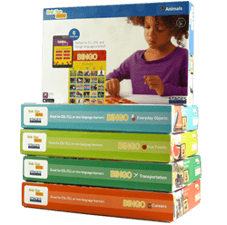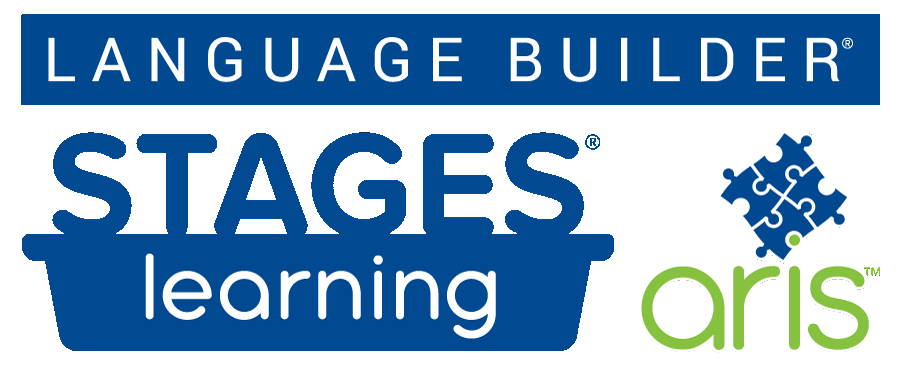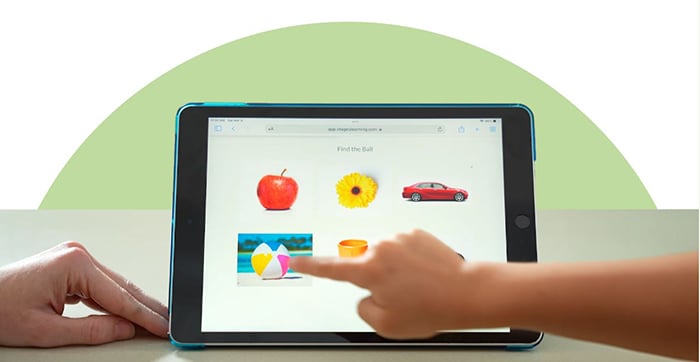
This resource was created as a supplement for the ARIS® Academic Readiness Intervention System Language Builder complete early autism curriculum, Lesson #23, Receptive Learning in Books. Download a free copy of the lesson and learn more about the ARIS curriculum.
Beginning at a young age, many autistic children can find it difficult to relate to and communicate with other people, and thus may have significant difficulty in expressive and receptive language (Simpson, Keen, & Lamb, 2015). Difficulties in language development can impact later functional outcomes, such as maintaining successful relationships and communicating wants and needs effectively. For autistic students, receptive language development is extremely important, as support in this area allows them to understand other’s requests and the surrounding environment. Thus, early intervention to support language development in young autistic children is necessary.
As teachers, there are many fun and engaging activities that you can do to support children’s receptive language development while keeping their attention and developing the whole child! Check out the four ideas below:
1. Utilize games
The ARIS Language Builder combines the trusted Language Builder Picture Card sets with 3D manipulatives, detailed lesson plans, black-line masters for various activity sheets, a system for record-keeping, and custom home communication forms for the most complete early autism education curriculum available. Within these lessons are a wealth of resources and teacher supports to facilitate learning for autistic children. The lessons on receptive labeling offer various games and activities that teachers can try with their students that are engaging and support the whole child.
For example, the following games, many of which will likely feel familiar, are engaging games to play that not only foster a sense of competition but also promote social development and interaction and can be adapted to facilitate student’s receptive language skills through receptive labeling.
Head, Shoulders, Knees, and Toes
An age-old game, Head, Shoulders, Knees, and Toes is a great way for autistic children to practice their receptive labeling skills. Once the child has mastered the body parts head, shoulders, knees, toes, eyes, ears, mouth, and nose, you can introduce these body parts in this well-known children’s song. Doing so will add a fun and engaging spin on the child’s therapy and teach a socially appropriate circle-time song they can do with their peers. You can also make up new words to the song to teach the child other body parts and increase engagement: Neck, elbows, hips, and ankles, for example.
Bingo
 Another classic game, Bingo is essentially a receptive labeling activity in disguise! As soon as the child can identify a few basic 2D Noun Pictures, you can turn the activity into a Bingo game by placing the known noun images on a table in a grid pattern. Using a small item to serve as a bingo marker, the student covers the picture that matches the word you call out. You can use the STAGES® Learning Bingo Cards to help your students add to their vocabulary.
Another classic game, Bingo is essentially a receptive labeling activity in disguise! As soon as the child can identify a few basic 2D Noun Pictures, you can turn the activity into a Bingo game by placing the known noun images on a table in a grid pattern. Using a small item to serve as a bingo marker, the student covers the picture that matches the word you call out. You can use the STAGES® Learning Bingo Cards to help your students add to their vocabulary.
Scavenger Hunt
A scavenger hunt can be a great receptive labeling activity, especially for colors. Collect a deck of various colors and give the first color to a student. Then, ask the student to find something in the room that is the same color. Once the student can find the specified color with the color card in their hands, ask them to find something that is a specific color without showing them the color card first!
Memory
 This game is a modified version of the memory game that teaches your students different careers. Using the occupation picture cards from the Language Builder: Occupation Cards, or simply cutting out real-life images from magazines of people engaging in different careers you can help your child learn common occupations and recognize people such as bus drivers and police officers. Begin by placing multiple pairs of occupation cards on the table face up in a random arrangement, and then ask the student to find the matched pairs. To support the student in working on their receptive labeling skills, ask the child to specifically find a certain occupation, like “firefighters.” You can also narrate for the students as they search for the cards, reinforcing them when they find one occupation and encouraging them to find the matching card.
This game is a modified version of the memory game that teaches your students different careers. Using the occupation picture cards from the Language Builder: Occupation Cards, or simply cutting out real-life images from magazines of people engaging in different careers you can help your child learn common occupations and recognize people such as bus drivers and police officers. Begin by placing multiple pairs of occupation cards on the table face up in a random arrangement, and then ask the student to find the matched pairs. To support the student in working on their receptive labeling skills, ask the child to specifically find a certain occupation, like “firefighters.” You can also narrate for the students as they search for the cards, reinforcing them when they find one occupation and encouraging them to find the matching card.
I Spy
With just a slight twist, the classic I Spy game can become a receptive labeling activity. In this game, you can provide the student with a word that is present in the environment. For example, you can say, “I spy…something Red.” The student should respond by going to the object or pointing at it. Additionally, this I Spy game is great to do with other peers to increase social interaction. In this way, the student is learning receptive labels while engaging in social skills and play activities with others.
Musical Chairs
Want to get your students up and moving? Try musical chairs! This classic can also become a receptive labeling activity. For example, you can practice receptively labeling verbs with your students through musical chairs by placing one verb card from the Language Builder: Verbs and Action Words Set on the seat of each chair. Then, after starting upbeat, kid-friendly music, students will begin walking around the circle of chairs. Once the music stops, you can call out one verb. The student should run to the chair with the correct verb card. To increase rigor and student engagement, have the student act out or mime the verb!
2. Incorporate the Senses
One way to facilitate receptive language development for autistic students is by utilizing sensory play. Once the student can identify a few basic 3D items, you can add a fun twist and a great sensory activity by having the student receptively identify 3D objects hidden in a sensory medium like sand, water, foam peanuts, or other sensory material. This will not only reinforce 3D object identification but also create a valuable sensory experience for autistic students.
3. Utilize Storybooks
As autistic students are practicing receptively labeling colors, you can utilize storybooks to help the student generalize their primary colors. For example, storybooks such as Brown Bear, Brown Bear, What Do You See? can provide a fun and natural way to help students identify their colors. Additionally, this is a great opportunity to involve other classmates to facilitate not only student’s receptive language development but also their social development.
4. Don’t Be Afraid of Technology!
Looking for ways to engage your students through technology? Since many students have learned to participate in remote learning, technological tools to support students have become a necessity. One great resource is the Stages Learning See.Touch.Learn app, available to download on various smart devices. This app is based on the Language Builder Picture Noun Cards, Sets 1 & 2, which are used to teach basic language skills to autistic children. If you would like to try before you buy, you can download the free version!
These tips are sure to facilitate the receptive language development of autistic students. Happy teaching!
References
Simpson, Kate & Keen, Deb & Lamb, Janeen. (2015). Teaching receptive labeling to autistic children: A comparative study using infant-directed song and infant-directed speech. Journal of Intellectual and Developmental Disability.
This resource was created as a supplement for the ARIS Language Builder complete early autism curriculum, Lesson #23, Receptive Learning in Books. Download a free copy of the lesson and learn more about the ARIS curriculum.





